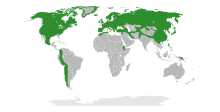Saxifragaceae
| Saxifragaceae | |
|---|---|
 | |
| Foamflower | |
Scientific classification | |
| Kingdom: |
Plantae |
Clade: |
Angiosperms |
Clade: |
Eudicots |
| Order: |
Saxifragales |
| Family: |
Saxifragaceae Juss. |
| Genera | |
Many, see text | |
 | |
| The range of Saxifragaceae. | |
Saxifragaceae is a plant family with about 640 known species in 33 accepted genera.[1]
The flowers are hermaphroditic and actinomorphic. They have 4 or 5 petals and 5 or 10 stamens.
Well known species include:
- Bergenia cordifolia
- Saxifraga stellaris
- Saxifraga oppositifolia
- Saxifraga paniculata
Parnassiaceae have sometimes been treated as part of this family, although they are only distantly genetically related and are now placed in Celastraceae.[2] The family does not include the genus Sassafras, despite the possibly related Latin etymology of the names.
Contents
1 Genera
2 Evolution
3 References
4 External links
Genera
Astilbe – false goat's-beards- Astilboides
Bensoniella – Oregon bensoniella- Bergenia
Bolandra – false coolworts
Boykinia – brookfoams
Chrysosplenium – golden-saxifrages
Conimitella Rydb.
Darmera – Indian rhubarb (synonym Peltiphyllum)
Elmera Rydb.
Hemieva Raf.
- Heterisia
Heuchera – Coral bells- Hieronymusia
- Hirculus
- Hydatica
- Jepsonia
Leptarrhena R.Br.
- Leptasea
- Limnobotrya
Lithophragma – woodlandstars
Micranthes Haw.
Mitella – miterworts
Mukdenia – mukdenias- Neoboykinia
- Oreotrys
- Oresitrophe
- Ozomelis
- Pectiantia
- Peltoboykinia
- Rodgersia
- Saniculiphyllum
Saxifraga – Saxifrages
Saxifragella Engl. (sometimes included in Saxifraga)- Saxifragodes
Saxifragopsis Small (sometimes included in Saxifraga)- Spatularia
- Steiranisia
Suksdorfia Gray
Sullivantia Torr. & Gray ex Gray – coolworts
- Tanakaea
Telesonix Raf.
Tellima – Fringecups- Therofon
Tiarella – foamflowers
Tolmiea – Piggyback plant
Evolution
Saxifragaceae are found mostly in the Northern Hemisphere, with centers of diversity in the Himalayas, East Asia, and Western North America. The greatest diversity is in the Pacific Northwest region of North America.[3]
The family is divided into two main lineages – the saxifragoids, which includes genera Saxifraga and Saxifragella, and the heucheroids, which includes all the other genera. The heucheroids are composed of eight tribes: Darmera (Astilboides, Bergenia, Darmera, Mukdenia, Orestitrope, and Rodgersia), Heuchera (Bensoniella, Conimitella, Elmera, Heuchera, Mitella, Tellima, Tiarella, and Tolmiea), Peltoboykinia (Chrysosplenium and Peltoboykinia), Micranthes (Micranthes), Boykinia (Boykinia, Bolandra, Hieronymusia, Jepsonia, Lithophragma, Sullivantia, Suxdorfia and Telesonix), Saniculphyllum (Saniculphyllum), Leptarrhena (Leptarrhena and Tanakaea), Astilbe (Astilbe and Saxifragopsis), and Cascadia (Cascadia and Saxifragoides).[3]
References
^ Christenhusz, M. J. M. & Byng, J. W. (2016). "The number of known plants species in the world and its annual increase". Phytotaxa. 261 (3): 201–217. doi:10.11646/phytotaxa.261.3.1..mw-parser-output cite.citation{font-style:inherit}.mw-parser-output .citation q{quotes:"""""""'""'"}.mw-parser-output .citation .cs1-lock-free a{background:url("//upload.wikimedia.org/wikipedia/commons/thumb/6/65/Lock-green.svg/9px-Lock-green.svg.png")no-repeat;background-position:right .1em center}.mw-parser-output .citation .cs1-lock-limited a,.mw-parser-output .citation .cs1-lock-registration a{background:url("//upload.wikimedia.org/wikipedia/commons/thumb/d/d6/Lock-gray-alt-2.svg/9px-Lock-gray-alt-2.svg.png")no-repeat;background-position:right .1em center}.mw-parser-output .citation .cs1-lock-subscription a{background:url("//upload.wikimedia.org/wikipedia/commons/thumb/a/aa/Lock-red-alt-2.svg/9px-Lock-red-alt-2.svg.png")no-repeat;background-position:right .1em center}.mw-parser-output .cs1-subscription,.mw-parser-output .cs1-registration{color:#555}.mw-parser-output .cs1-subscription span,.mw-parser-output .cs1-registration span{border-bottom:1px dotted;cursor:help}.mw-parser-output .cs1-ws-icon a{background:url("//upload.wikimedia.org/wikipedia/commons/thumb/4/4c/Wikisource-logo.svg/12px-Wikisource-logo.svg.png")no-repeat;background-position:right .1em center}.mw-parser-output code.cs1-code{color:inherit;background:inherit;border:inherit;padding:inherit}.mw-parser-output .cs1-hidden-error{display:none;font-size:100%}.mw-parser-output .cs1-visible-error{font-size:100%}.mw-parser-output .cs1-maint{display:none;color:#33aa33;margin-left:0.3em}.mw-parser-output .cs1-subscription,.mw-parser-output .cs1-registration,.mw-parser-output .cs1-format{font-size:95%}.mw-parser-output .cs1-kern-left,.mw-parser-output .cs1-kern-wl-left{padding-left:0.2em}.mw-parser-output .cs1-kern-right,.mw-parser-output .cs1-kern-wl-right{padding-right:0.2em}
^ Angiosperm Phylogeny Group (2016). "An update of the Angiosperm Phylogeny Group classification for the orders and families of flowering plants: APG IV". Botanical Journal of the Linnean Society. 181 (1): 1–20. doi:10.1111/boj.12385.
^ ab Deng, Jia-bin; Drew, Bryan T.; Mavrodiev, Evgeny V.; Gitzendanner, Matthew A.; Soltis, Pamela S.; Soltis, Douglas E. (2015). "Phylogeny, divergence times, and historical biogeography of the angiosperm family Saxifragaceae". Molecular Phylogenetics and Evolution. 83: 86–98. doi:10.1016/j.ympev.2014.11.011. PMID 25479063.
External links
Wikispecies has information related to Saxifragaceae |
 Media related to Saxifragaceae at Wikimedia Commons
Media related to Saxifragaceae at Wikimedia Commons
 . Encyclopædia Britannica. 24 (11th ed.). 1911.
. Encyclopædia Britannica. 24 (11th ed.). 1911.
- Saxifragaceae in Topwalks
This Saxifragaceae-related article is a stub. You can help Wikipedia by expanding it. |

Comments
Post a Comment